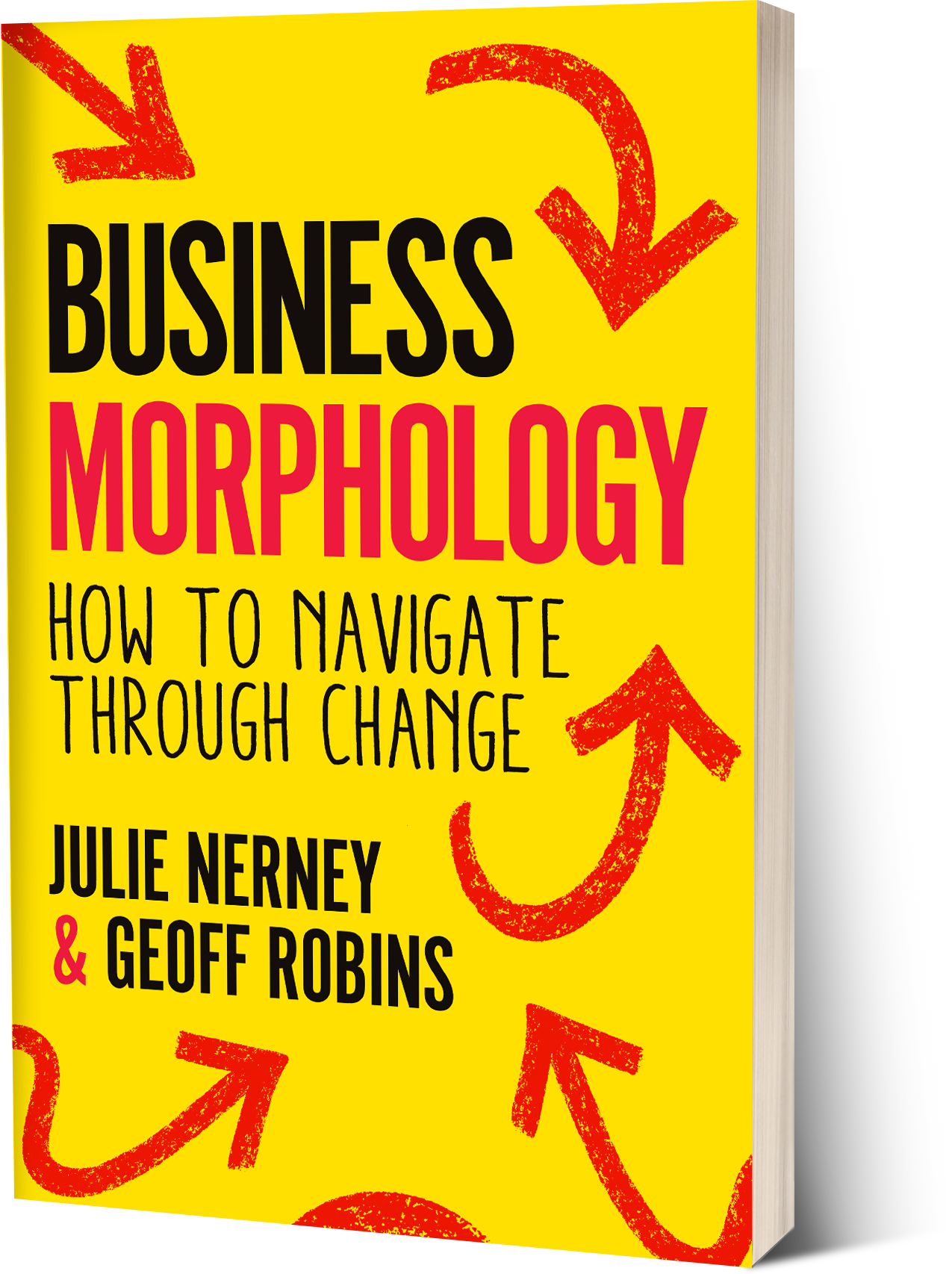Morphology Unpacked
What do we mean by Morphology? Well, it’s a blend of two terms:
Morph (v):
to gradually, change, or change someone or something, from one thing or another; and
Ology (n):
a science or other branch of knowledge
The combination of these two terms is the foundation of the best-selling book Business Morphology, which seeks to address the core question facing leaders and managers everywhere: how do you change the form and structure of your organization for the better, and what are the important things you need to consider and plan for when doing it?
Business Morphology - The Book
Standing still in today’s business environment is not an option if you are to survive and thrive. But navigating your way through change can be complex, challenging and daunting. Business Morphology is here to help break down this complexity and is based upon 75 years of experience, and having helped organisations across every sector build powerful plans of action.
Whatever challenges your organisation is facing, there are five fundamental levers that you can apply to effect real change. This book explores each of those five levers through a Morphology Map – an easy-to-use visual tool to help guide your thinking, prioritisation, and create a plan of action to help ensure you reach your outcomes. As an added bonus, there is also a Morphology Map to help you maximise your own personal impact too.

The authors

Julie Nerney
Chartered Director (CDir), Fellow of the Institute of Directors (FIoD)
Julie was a serial entrepreneur, starting, running and selling 14 business in the UK and overseas. She then had a successful interim career as a business transformation expert, spanning private, public and not for profit sectors. These ranged from complex change programmes through to whole organisational turnarounds and high profile projects, including a leadership role in the delivery of the transport operation for the London 2012 Olympic and Paralympic games.
She has experience of every stage of the organisational life cycle from start up through to disposals and acquisitions, and has worked in dozens of Executive and CEO roles. Her transformation work is complemented by a varied portfolio of Chair and NED roles, she is a guest lecturer at Oxford Said Business School, public speaker and author.
Whilst her experience has real breadth and depth, Julie is struck by the commonality across the hundreds of organisations she has worked with. Regardless of why there are there, how teams and leaders approach their work is a far bigger determinant than what they do. The what is important, but it is the how which is the game changer.

Geoff Robins
BSc, Ph.D
Geoff was educated at Liverpool University, where he studied Physics. After an early career working for the UK Government, Geoff turned to the private sector, operating and leading technical consulting organisations ranging from SMEs to a major portfolio within a UK Plc. Along the way Geoff was involved in the acquisition and sale of a range of different organisations including two management buy outs.
Latterly Geoff was the Transformation Director for two major Government organisations, both of which employed thousands of staff throughout the UK and overseas. He is now a strategic advisor and Non-Executive Director to a number organisations in sectors that are high growth and fast moving. Away from work Geoff has a passion for sport and has been responsible for the management and growth in the participation and engagement of volunteers to achieve exceptional outcomes through collective endeavours. This experience has been invaluable in his working life in terms of getting buy-in and motivating people to go the extra mile.
Content Sample
Chapter 1: The Morphology Maps – How to Navigate Through Change
“Standing still is the fastest way of moving backwards in a rapidly changing world” (Lauren Bacall)
Context for this book
We know from our extensive experience of designing and leading change, that altering the way in which an organization operates, is structured, or works, can be described in a range of different ways. It could be branded a change programme, or badged with the increasingly over used label of transformation. In our opinion what these terms express are two ends of a spectrum: a transformation is something that can never revert to its former state – like a caterpillar turning into a butterfly – whereas a change is something that could be reversed or replaced, like a system or process update. Irrespective of where you sit on this spectrum, in the context of this book we describe any implementation of change as morphing – changing from one state to another as seamlessly as possible, at a pace that is dictated by the environment in which you find yourself.
Business Morphology Maps
The process of change can be complex, challenging and even daunting. Business Morphology is here to help break down this complexity so that you can start to put together a coherent and realistic plan of what to do and when. At the heart of Business Morphology are the Morphology Maps, which are an easy to use, visual tool to help guide your thinking and prioritisation.
Change levers
In our experience, there are five fundamental levers that can be applied to effect real change in an organization. They are:
- Modifying your Operating Model
- Product or Service Diversification
- Mergers or Acquisitions
- People
- Culture
Each of these five change levers are considered in the following chapters of the book. For each one we have developed a Morphology Map. Each Map is accompanied by a narrative which brings it to life in terms of why the control and influence elements included in the maps, and their various inter-relationships, matter. This narrative is supported by case studies with insights into where each change lever has, or has not, been successful, providing valuable learning.
Foundation for your plan of action
A Morphology Map is not your plan. The power of the Map is to help you identify the things that are important to consider so that they form the foundation of a rigorous plan of who does, what and when to get to your desired outcomes.
An added bonus
In addition to the change lever chapters, we have also included a chapter focused on you, the individual. Because ultimately, wherever you are in an organization, you’re either leading or taking part in change.
Chapter 2: Modifying your Operating Model
“If you don’t drive your business, you will be driven out of business” (B C Forber)
An operating model is a description of the people, processes and systems that make your business tick. Understanding these core components and how they interact is vital to ensuring your business is operating efficiently.
There is an almost continuous pressure for every organization to operate more efficiently, and to maintain or improve profit margins. Increasing efficiency requires absolute clarity on what and how you are spending your time, effort and money on now and then identifying where changes are required to save time, effort and money in the future. So what are the things you need to consider when you are modifying your operating model ?
Chapter 3: Product or Service Diversification
“Wonder what your customer really wants? Ask, don’t tell” (Lisa Stone CEO of Blogher)
All products and services have a natural lifecycle. This lifecycle will vary in time between market sectors, but successful organizations have a portfolio of products and services that are coherent over time: as one product or service declines, another enters its growth or maturity phase.
But the successful generation and launch of new products and services is not straightforward. It requires an entrepreneurial flair that identifies a gap in the market in which you are operating, or seizes on the introduction of new technology or ideas to create a new market need. So what are the key steps and issues to consider when undertaking product or service diversification?
Chapter 4: Mergers and Acquisitions
“If opportunity doesn’t knock, build a door” (Milton Berle)
On the face it this lever can look like the option to move your business forward fastest. A big step forward rather than incremental, organically driven change. But without doubt this is at the top of the risk scale and research indicates than c80% of mergers or acquisitions (M&A) fail to deliver the value they set out to achieve.
That shouldn’t deter you from pursuing this option if it is the right strategic choice, but it should strengthen your resolve to ensure you develop a credible plan that enables you to avoid the pitfalls that beset undertakings of this nature. So what are the key steps and issues to consider when undertaking a merger or acquisition?
Chapter 5: People
“You don’t build a business, you build people, the people build the business” (Zig Ziglar)
Without the right people no business can succeed. In our experience, it is always, always, always about the people. They are the reason why you are able to deliver. But a high performing workforce gives you so much more.
Creating an environment that develops and encourages people is far from easy. It takes conscious effort, and specific actions. And, like the culture lever, it is not a one-off project – it is an evolution. As your business morphs, so will your people need to morph too. So what are the key steps and issues to consider when undertaking people change?
Chapter 6: Culture
“Culture is a set of living relationships working towards a shared goal. It’s not something you are, it’s something you do” (Daniel Coyle)
The culture of an organization is its glue, it’s the DNA. It fills the gaps between the processes and work instructions and binds staff together with a common purpose.
The net effect of getting your culture right is a high performing team that goes the extra mile, where staff feel a strong sense of loyalty and belonging. It also differentiates you from your competition. Organizations who recognise the competitive advantage that culture brings them also design it into the way they manage the performance of their people. So what are the key steps and issues to consider when undertaking culture change?
Chapter 7: Maximising Your Personal Impact
“How do you become better tomorrow? By improving yourself, the world is made better. Be afraid of standing still. Forget your mistakes but remember what they taught. So how do you become better tomorrow? By becoming better today.” (Benjamin Franklin)
You could argue the only reason people go to work is to earn money. However for many, money is only one of several motivating factors. Whatever your motivation, it is vitally important to ensure that you feel valued and you can see that you are making a contribution to the organization you work for. And when the organization you work for is going through a time of change It can be very stressful. Navigating your way through all this is not easy. This Chapter is designed to help you to build a plan so that you can start to take ownership of your own performance and contribution.
Chapter 8: Bringing it all together
Every business needs to morph to survive and thrive and every business will go through one or more of the five levers in this book multiple times over its lifetime. Those that don’t won’t stay around. Some levers will be pulled singularly, or it may well be a combination of different levers all being used at the same time.
Although each of the levers described in this book have a number of unique elements that need to be accommodated in your overall plan of action, there are also a number of themes that are common across all the levers and this chapter brings them altogether.

